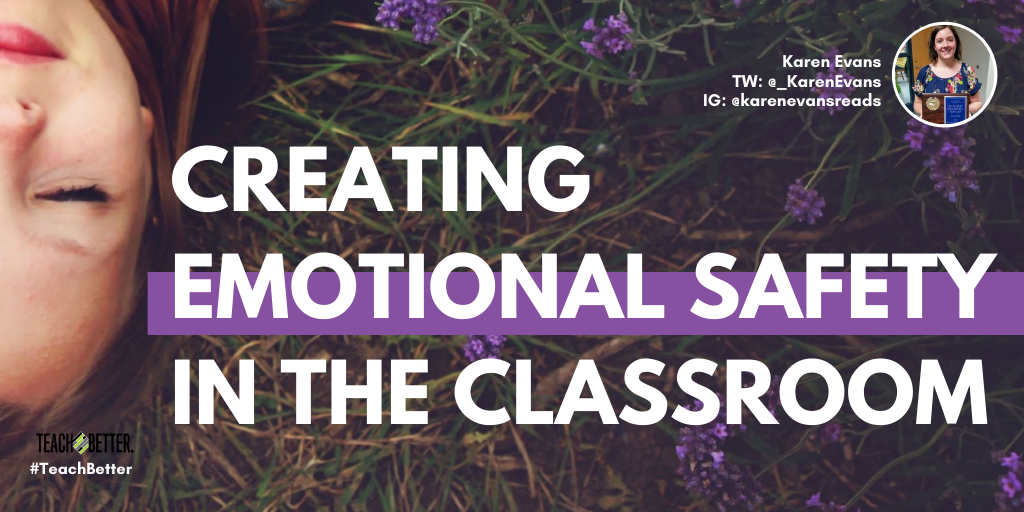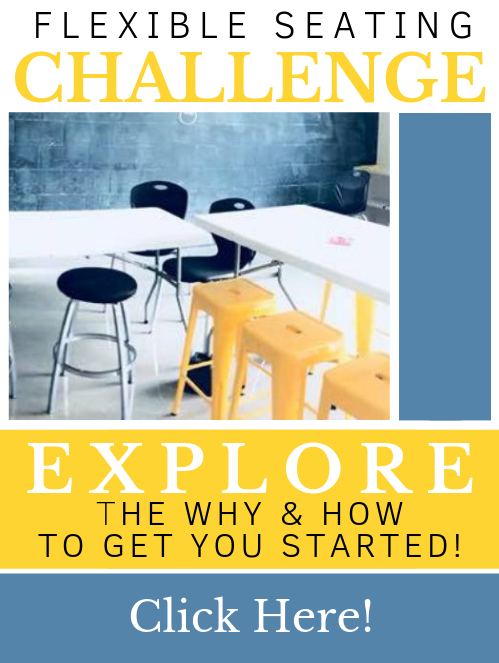In This Post:
- The five areas for creating emotional safety in your classroom.
- Detailed tips on how to meet the emotional needs of your students.
- One teacher’s experience creating an emotionally safe community for her students.
 In today’s world of active shooter drills and trauma-informed instruction, how do we create emotional safety in our classroom communities?
In today’s world of active shooter drills and trauma-informed instruction, how do we create emotional safety in our classroom communities?
I recently read Fostering Resilient Learners: Strategies for Creating a Trauma-Sensitive Classroom by Kristin Souers and Pete Hall. The portion on student safety was particularly interesting. It helped me form a mental checklist to run through as I reflected on the procedures and routines present within our classroom.
Kristin Souers identified five important factors that contribute to a safe classroom environment:
- Assigned seating
- Check-in and check-out
- Posting of pictures
- Notes or calls home
- Rituals
Join me as I share what has worked within my intensive resource room and add to the conversation by sharing what emotional safety looks like in your classroom.
In today's world of active shooter drills and trauma-informed instruction, how do we create emotional safety in our classroom communities? Click To TweetAssigned Seating
Flexible seating fans, don’t freak out! The recommendation for assigned seating does not mean that flexible seating can’t be used, but reminds teachers to protect the right for each child to have a home base. This provides students with the message that they belong and allows them to have a place that is theirs. School may be the only environment where they have a location to safely store their belongings and one to go to when they need some solo time.
In my classroom, my students with intense behavioral needs have their own desks. They also have choice throughout the day on where they sit. Much of our day is spent playing running games to practice math and reading skills or engaging in other gross-motor activities. Students are rarely at their desks, but their assigned seats are always available to them.
[scroll down to keep reading]Check-in and Check-out
Students need a positive experience with an adult at the start of each day. Not only does a check-in set the tone for students, it also allows educators the opportunity to conduct a quick “temperature check.”
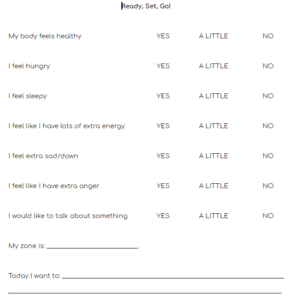 Morning Routine
Morning Routine
In the intensive resource room, students select their preferred greeting from signs offering them a wave, high five, fist pump, hug, or dance party. After they enter, they affirm themselves and are reminded of our classroom expectations, “I am respectful, I’m safe, I go with the plan.”
Students move their photograph to colored sheets of paper to show what Zone they are in. Then they grab a “Ready, Set, Go” clipboard and find an adult for check-in. A copy of what we use is linked, but the teacher or paraprofessional of their choice essentially runs through a series of questions about basic needs, emotions, 0r anything the student wants to talk about.
Children move to their desks and begin their morning task: drawing a picture of their goal for the day and practicing their “autographs” (handwriting). Finally, students join us for morning circle and mindfulness, which complete our check-in procedure. While this may seem incredibly time consuming (it is), it’s well worth it!
Whole Day Reflection
Throughout the day, students reflect on their behavior and complete a daily challenge sheet. 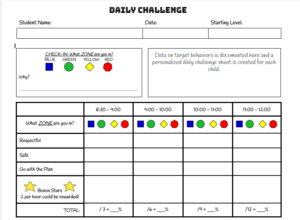 Teachers have a master copy in a clear pocket to write on with wet erase markers throughout the day. It is, however, always completed alongside the children. Adults ask each hour, “What is your zone? Were you respectful? Were you safe? Did you go with the plan?”
Teachers have a master copy in a clear pocket to write on with wet erase markers throughout the day. It is, however, always completed alongside the children. Adults ask each hour, “What is your zone? Were you respectful? Were you safe? Did you go with the plan?”
This mini conference allows students the opportunity to reflect on what went well and why, and lends itself to spontaneous reflection as students internalize the process and develop an internal locus of control. It also promotes self-regulation strategies. At the end of the day, a final percentage is determined, levels are changed, and students have “end game” (choice) time with more exciting options as the levels increase.
Posting of Pictures
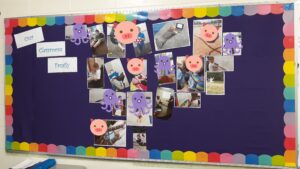
Kristin Souers says, “Photos of students throughout the classroom and school send a message of family and belonging.”
In my personal life, I follow the Miracle Morning routine and know the importance of visualization. I want my children to be reminded of their successes too and allow their visuals to launch them into discovering their dreams. For the eleven years I’ve been teaching, I’ve always maintained at least one bulletin board dedicated to photos of students engaging in learning and being successful. In two years of teaching children with intense behavioral needs, not a single photograph has been removed or destroyed. Not one.
Notes or Calls Home
For children with self-regulation needs, their parents are often accustomed to a great deal of negative reporting from teachers. Not only do I send our daily challenge, goals, and Ready Set Go sheets home daily, but I also email parents most days with good news and photographs. That helps show parents that they are part of the team and that we truly care about their child.
Rituals
Assessment Celebrations
Kristin Souers speaks of rituals as routines so students know what to expect. I feel I’ve covered those quite a bit already, so I’d like to share our classroom routines for celebrations. Because our students are in special education, there is progress monitoring to be completed weekly. Before each assessment, I have children raise their pencil in the air and lead them through some silly affirmations that make them laugh and set the tone.
Something I often say is, “I’m a brilliant mathematician! I’m going to rock this test! I’m going to beat my goal!” I pause after each statement for the students to repeat what I said. As the year progresses, students take charge of leading these chants. It’s empowering and fun!
Each student also has their own goal written on our board. In settings where I’ve had more students, we’ve kept these private by writing them on an index card and forming a goal flip book. When they beat their goal in math or reading, I cup my hands and announce, “Attention class, ___ beat their goal!!!” The louder the better! Kids love it.
For one of my students, I’ve recently added picking him up and spinning him around the room while freaking out about his success. Know your kids. Know what will work for them.
Behavior Celebrations
As far as behavior, I keep track of the children’s daily challenge percentages on a spreadsheet. Once a month, I calculate the median percentage as I prepare for positive behavior support meetings with our team.
When a child’s percentage has increased compared to the previous month, we throw them a party. I ask the child what theme they’d like and we invite parents and other school staff who are important to the child. We’ve had peanut butter and jelly themed parties, basketball parties, and this year, kids have been talking about top-chef junior and mystery themes. It’s something they remember even years later.
These are the things I currently do to create a safe classroom environment, but throughout the year, I’m constantly growing and changing as I learn more. What do these five attributes look like in your setting? Are there additional factors you feel contribute to a safe environment? I can’t wait to hear from you!
ABOUT KAREN EVANS
Karen Evans is an intensive resource room teacher in Muskegon, Michigan. She holds a Bachelor’s Degree in Special Education from Western Michigan University, a Master’s in Measurement and Evaluation from Western Governors University, and has dreams to start a master’s program in educational leadership with an emphasis on special education administration. Her goal is to use trauma-informed practices to make all students feel seen, heard, and loved as she equips them to see their own strengths, set and take ownership of learning goals, and achieve excellence. In her free time, Karen enjoys practicing yoga, hiking, and spending time with family and friends. She is also very involved in the book community reading and blogging about books before publication, meeting authors, and facilitating book clubs.


